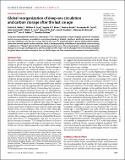Files in this item
Global reorganization of deep-sea circulation and carbon storage after the last ice age
Item metadata
| dc.contributor.author | Rafter, Patrick | |
| dc.contributor.author | Gray, William | |
| dc.contributor.author | Hines, Sophia K. V. | |
| dc.contributor.author | Burke, Andrea | |
| dc.contributor.author | Costa, Kassandra M. | |
| dc.contributor.author | Gottschalk, Julia | |
| dc.contributor.author | Hain, Mathis P. | |
| dc.contributor.author | Rae, James W. B. | |
| dc.contributor.author | Southon, John R. | |
| dc.contributor.author | Walczak, Maureen H. | |
| dc.contributor.author | Yu, Jimin | |
| dc.contributor.author | Adkins, Jess F. | |
| dc.contributor.author | DeVries, Tim | |
| dc.date.accessioned | 2022-11-17T16:30:24Z | |
| dc.date.available | 2022-11-17T16:30:24Z | |
| dc.date.issued | 2022-11-16 | |
| dc.identifier | 281674853 | |
| dc.identifier | c9028ed2-58e6-4776-b515-db79be23ae37 | |
| dc.identifier | 85142144824 | |
| dc.identifier.citation | Rafter , P , Gray , W , Hines , S K V , Burke , A , Costa , K M , Gottschalk , J , Hain , M P , Rae , J W B , Southon , J R , Walczak , M H , Yu , J , Adkins , J F & DeVries , T 2022 , ' Global reorganization of deep-sea circulation and carbon storage after the last ice age ' , Science Advances , vol. 8 , no. 46 , eabq5434 . https://doi.org/10.1126/sciadv.abq5434 | en |
| dc.identifier.issn | 2375-2548 | |
| dc.identifier.other | ORCID: /0000-0002-3754-1498/work/123195837 | |
| dc.identifier.other | ORCID: /0000-0003-3904-2526/work/123195840 | |
| dc.identifier.uri | https://hdl.handle.net/10023/26429 | |
| dc.description | Funding: This work was supported by grants from the National Science Foundation (OCE-2015647 and OCE-2032340 to PAR; OCE- 2032343 to MPH); NERC grant NE/N011716/1 to JWBR and NERC grant NE/M004619/1 to AB. | en |
| dc.description.abstract | Using new and published marine fossil radiocarbon (14C/C) measurements, a tracer uniquely sensitive to circulation and air-sea gas exchange, we establish several benchmarks for Atlantic, Southern, and Pacific deep-sea circulation and ventilation since the last ice age. We find the most 14C-depleted water in glacial Pacific bottom depths, rather than the mid-depths as they are today, which is best explained by a slowdown in glacial deep-sea overturning in addition to a “flipped” glacial Pacific overturning configuration. These observations cannot be produced by changes in air-sea gas exchange alone, and they underscore the major role for changes in the overturning circulation for glacial deep-sea carbon storage in the vast Pacific abyss and the concomitant drawdown of atmospheric CO2. | |
| dc.format.extent | 9 | |
| dc.format.extent | 2270717 | |
| dc.language.iso | eng | |
| dc.relation.ispartof | Science Advances | en |
| dc.subject | GE Environmental Sciences | en |
| dc.subject | GC Oceanography | en |
| dc.subject | DAS | en |
| dc.subject | MCC | en |
| dc.subject.lcc | GE | en |
| dc.subject.lcc | GC | en |
| dc.title | Global reorganization of deep-sea circulation and carbon storage after the last ice age | en |
| dc.type | Journal article | en |
| dc.contributor.sponsor | NERC | en |
| dc.contributor.sponsor | NERC | en |
| dc.contributor.institution | University of St Andrews. School of Earth & Environmental Sciences | en |
| dc.contributor.institution | University of St Andrews. St Andrews Isotope Geochemistry | en |
| dc.contributor.institution | University of St Andrews. Centre for Energy Ethics | en |
| dc.identifier.doi | 10.1126/sciadv.abq5434 | |
| dc.description.status | Peer reviewed | en |
| dc.date.embargoedUntil | 2022-11-16 | |
| dc.identifier.grantnumber | NE/N011716/1 | en |
| dc.identifier.grantnumber | NE/M004619/1 | en |
This item appears in the following Collection(s)
Items in the St Andrews Research Repository are protected by copyright, with all rights reserved, unless otherwise indicated.

